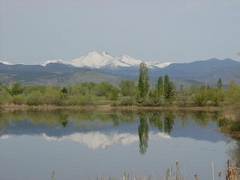 It's a little known fact that one of Colorado's first narrow-gauge railroads originated right here in Longmont, in the early 1880's. The story starts with some Longmont businessmen who were not happy with the "outlandish" high price of coal that Longmont was getting from the Marshall area, near Boulder. A good coal supply, obtained at a reasonable rate, was crucial to the survival of any Colorado town back then. With the discovery of the rich Rob Roy coal seam in the Canfield area, a railroad company was incorporated in 1878 with the chief purpose of getting coal to Longmont at a better price. Isaac Canfield himself was listed in the incorporation papers of the railroad known as the "Denver, Longmont, and Northwestern" line.
It's a little known fact that one of Colorado's first narrow-gauge railroads originated right here in Longmont, in the early 1880's. The story starts with some Longmont businessmen who were not happy with the "outlandish" high price of coal that Longmont was getting from the Marshall area, near Boulder. A good coal supply, obtained at a reasonable rate, was crucial to the survival of any Colorado town back then. With the discovery of the rich Rob Roy coal seam in the Canfield area, a railroad company was incorporated in 1878 with the chief purpose of getting coal to Longmont at a better price. Isaac Canfield himself was listed in the incorporation papers of the railroad known as the "Denver, Longmont, and Northwestern" line.The narrow gauge railroad was opened on November 24, 1881 and consisted of 8.2 miles of track between Longmont and Canfield. Leaving Longmont at Main & 2nd Avenue, the route went up over Empson Hill and crossed the St. Vrain and Boulder Creek on the way to Canfield. One-way trip time was 45 minutes.
The map above is from 1904, many years after the Baby Railroad was gone, but you can use it to imagine where the route used to be (Canfield is next to Erie) and you can also see the Marshall coal fields down by Superior.
A picture is here from the Longmont Museum, showing a model of what the locomotive looked like on this railroad line.
A few weeks later, in early 1882, the railroad was extended from Canfield to meet the larger Denver, Utah, and Pacific railroad line which opened up additional opportunities beyond just moving coal. Suddenly, Longmont citizens had a convenient way of getting to Denver at a cost of $2.50, for business and leisure. Excursions, Phyllis Smith writes, "were the main entertainment of the 1880s. " The trip time from Longmont to Denver was 1 hour, 35 minutes and horses belonging to passengers could be transported for an additional 40 cents. Rock quarried in Lyons was transported to Denver on this railroad, for their sidewalks and buildings. Longmont received visitors to local festivals such as early instances of the Pumpkin Pie Day and the Firemen's Masquerade Ball, on this train, and vice-versa, our residents ventured to ice skating contests and band concerts in the Canfield/Erie area. Clearly, the railroad had evolved to serve a much larger range of uses than its original charter.
What happened to Longmont's Baby Railroad? Competition swept in when the Colorado Central, owned by Union & Pacific, fought back with lower freight and excursion rates (50 cents from Longmont to Denver, through Golden). The operating company of Longmont's Baby Railroad was eventually bought out and in 1889, the narrow gauge tracks between Longmont and Canfield were ripped out.
Someday in the next decade, RTD's FasTraks will again offer Longmont residents a rail trip to Denver via Boulder. Will this perhaps kick off another "excursion age"?
Most of this information came from an excellent article in the November 23, 1981 Longmont Times-Call newspaper, written by Linda Burleigh, and also from Phyllis Smith's "Once a Coal Miner" book mentioned previously.
[Edit on December 18, 2017: Modernize the font]

 One citizen's view of Longmont, Colorado, USA.
One citizen's view of Longmont, Colorado, USA.

3 comments:
I'd be interested to know your source of the 1904 railroad map. I'm researching the Denver, Utah & Pacific Railroad, part of which is shown on the map.
Hi Eric,
Sorry, I missed this comment. Let me look it up!
Hi Eric,
The map is from a copy of the "Eldora Times" newspaper, circa 1904, which is reproduced in the back of the book "Boulder County Miners: A Tribute to Those Who Left Their Mark in Colorado History" by Delores Bailey. Hope this helps.
Post a Comment